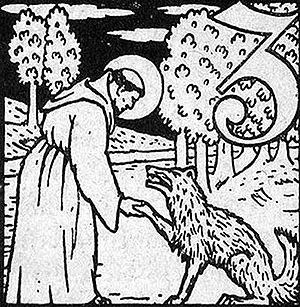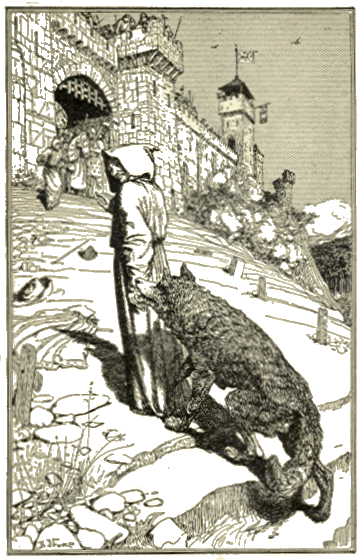
Wolf of Gubbio
Encyclopedia

Little Flowers of St. Francis
The Little Flowers of St. Francis is a florilegium , divided into 53 short chapters, on the life of Saint Francis of Assisi which was composed at the end of the 14th century...
, terrorized the city of Gubbio
Gubbio
Gubbio is a town and comune in the far northeastern part of the Italian province of Perugia . It is located on the lowest slope of Mt. Ingino, a small mountain of the Apennines. See also Mount Ingino Christmas Tree.-History:...
until it was tamed by St. Francis of Assisi acting on behalf of God. The story is one of many in Christian narrative that depict holy persons exerting influence over animals and nature, a motif common to hagiography
Hagiography
Hagiography is the study of saints.From the Greek and , it refers literally to writings on the subject of such holy people, and specifically to the biographies of saints and ecclesiastical leaders. The term hagiology, the study of hagiography, is also current in English, though less common...
.
Story
During the period when Francis was living in Gubbio, a fierce wolf appeared in the country and began attacking livestock. Soon the wolf graduated to direct assaults on humans, and not long after began to dine upon them exclusively. It was known for lingering outside of the city gates in wait for anyone foolish enough to venture beyond them alone. No weapon was capable of inflicting injury upon the wolf, and all who attempted to destroy it were devoured. Eventually mere sight of the animal caused the entire city to raise alarm and the public refused to go outside the walls for any reason. It was at this point, when Gubbio was under siege, that Francis announced he was going to take leave and meet the wolf. He was advised against this more than once but, irrespective of the warnings, made the sign of the CrossChristian cross
The Christian cross, seen as a representation of the instrument of the crucifixion of Jesus Christ, is the best-known religious symbol of Christianity...
and went beyond the gates with a small group of followers in tow. When he neared the lair of the wolf the crowd held back at a safe distance, but remained close enough to witness what transpired.
The wolf, having seen the group approach, rushed at Francis with its jaws open. Again Francis made the sign of the Cross and commanded the wolf to cease its attacks in the name of God, at which point the wolf trotted up to him docilely and lay at his feet, putting its head in his hands. The Fioretti then describes word-for-word his dealings with the wolf:
- "Brother wolf, thou hast done much evil in this land, destroying and killing the creatures of God without his permission; yea, not animals only hast thou destroyed, but thou hast even dared to devour men, made after the image of God; for which thing thou art worthy of being hanged like a robber and a murderer. All men cry out against thee, the dogs pursue thee, and all the inhabitants of this city are thy enemies; but I will make peace between them and thee, O brother wolf, is so be thou no more offend them, and they shall forgive thee all thy past offences, and neither men nor dogs shall pursue thee any more."
The wolf bowed its head and submitted to Francis, completely at his mercy.
- "As thou art willing to make this peace, I promise thee that thou shalt be fed every day by the inhabitants of this land so long as thou shalt live among them; thou shalt no longer suffer hunger, as it is hunger which has made thee do so much evil; but if I obtain all this for thee, thou must promise, on thy side, never again to attack any animal or any human being; dost thou make this promise?"
In agreement, the wolf placed one of its forepaws in Francis' outstretched hand, and the oath was made. Francis then commanded the wolf to return with him to Gubbio. Meanwhile the townsfolk, having heard of the miracle, gathered in the city marketplace to await Francis and his companion, and were shocked to see the ferocious wolf behaving as though his pet. When Francis reached the marketplace he offered the assembled crowd an impromptu sermon with the tame wolf at his feet. He is quoted as saying: "How much we ought to dread the jaws of hell
Hell
In many religious traditions, a hell is a place of suffering and punishment in the afterlife. Religions with a linear divine history often depict hells as endless. Religions with a cyclic history often depict a hell as an intermediary period between incarnations...
, if the jaws of so small an animal as a wolf can make a whole city tremble through fear?" With the sermon ended Francis renewed his pact with the wolf publicly, assuring it that the people of Gubbio would feed it from their very doors if it ceased its depredations. Once more the wolf placed its paw in Francis' hand.

Aftermath
Thereafter Gubbio venerated Francis and he received great praise from its citizens. Many of them were convinced by the miracle and offered their thanks to God, going on to be convertedReligious conversion
Religious conversion is the adoption of a new religion that differs from the convert's previous religion. Changing from one denomination to another within the same religion is usually described as reaffiliation rather than conversion.People convert to a different religion for various reasons,...
. This episode in the Fioretti is concluded with a note that the wolf lived for a further two years at Gubbio, going from home to home for sustenance and honoring the provisions of its agreement with Francis. At its death the city was saddened, for even though it had slain so many it was a symbol of the sanctity of Francis and the power of God. The National Gallery, London
National Gallery, London
The National Gallery is an art museum on Trafalgar Square, London, United Kingdom. Founded in 1824, it houses a collection of over 2,300 paintings dating from the mid-13th century to 1900. The gallery is an exempt charity, and a non-departmental public body of the Department for Culture, Media...
has a polyptych by Sassetta in the Sainsbury Wing, depicting scenes from the life of Saint Francis, and it includes a scene depicting Saint Francis making a pact with the Wolf.
See also
- Christian literatureChristian literatureChristian Literature is writing that deals with Christian themes and incorporates the Christian world view. This constitutes a huge body of extremely varied writing.-Scripture:...
- Christian mysticismChristian mysticismChristian mysticism refers to the development of mystical practices and theory within Christianity. It has often been connected to mystical theology, especially in the Catholic and Eastern Orthodox traditions...
- ChristianizationChristianizationThe historical phenomenon of Christianization is the conversion of individuals to Christianity or the conversion of entire peoples at once...
- Order of Friars MinorFranciscanMost Franciscans are members of Roman Catholic religious orders founded by Saint Francis of Assisi. Besides Roman Catholic communities, there are also Old Catholic, Anglican, Lutheran, ecumenical and Non-denominational Franciscan communities....
- List of saints
- List of wolves
- Middle AgesMiddle AgesThe Middle Ages is a periodization of European history from the 5th century to the 15th century. The Middle Ages follows the fall of the Western Roman Empire in 476 and precedes the Early Modern Era. It is the middle period of a three-period division of Western history: Classic, Medieval and Modern...
- Wolves in folklore, religion and mythology

